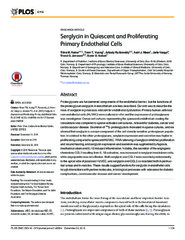| dc.description.abstract | Proteoglycans are fundamental components of the endothelial barrier, but the functions of
the proteoglycan serglycin in endothelium are less described. Our aim was to describe the
roles of serglycin in processes relevant for endothelial dysfunction. Primary human umbilical
vein endothelial cells (HUVEC) were cultured in vitro and the expression of proteoglycans
was investigated. Dense cell cultures representing the quiescent endothelium coating the
vasculature was compared to sparse activated cell cultures, relevant for diabetes, cancer and
cardiovascular disease. Secretion of 35S- proteoglycans increased in sparse cultures, and we
showed that serglycin is a major component of the cell-density sensitive proteoglycan population.
In contrast to the other proteoglycans, serglycin expression and secretion was higher in
proliferating compared to quiescent HUVEC. RNAi silencing of serglycin inhibited proliferation
and wound healing, and serglycin expression and secretion was augmented by hypoxia,
mechanical strain and IL-1β induced inflammation. Notably, the secretion of the angiogenic
chemokine CCL2 resulting from IL-1β activation, was increased in serglycin knockdown cells,
while angiopoietin was not affected. Both serglycin and CCL2 were secreted predominantly
to the apical side of polarized HUVEC, and serglycin and CCL2 co-localized both in perinuclear
areas and in vesicles. These results suggest functions for serglycin in endothelial cells
trough interactions with partner molecules, in biological processes with relevance for diabetic
complications, cardiovascular disease and cancer development. | en_US |


 English
English norsk
norsk